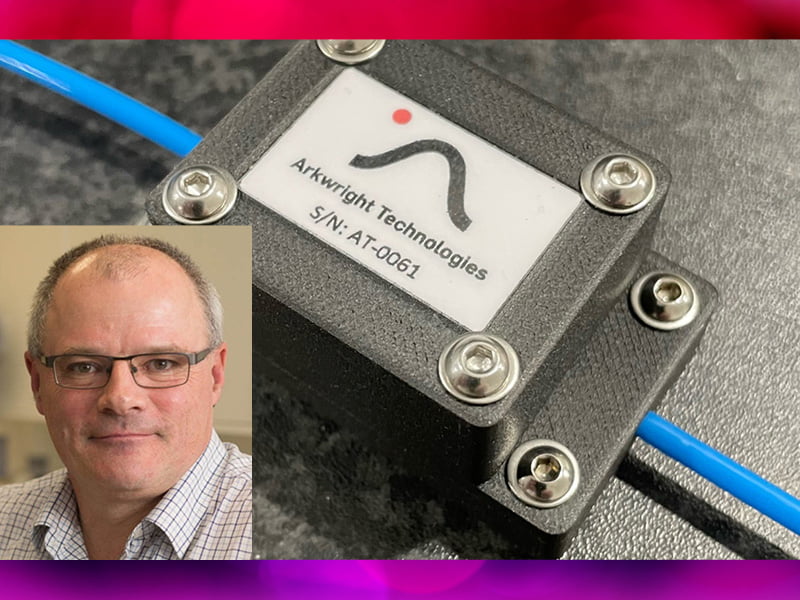Dr John Arkwright is an inventor and discoverer who set himself a challenge when founding Arkwright Technologies – to measure pressure inside the body using optical fibre.
“I developed a pressure sensing array that was small enough to be fed into the human gastrointestinal tract,” said Dr Arkwright, managing director and founder of Arkwright Technologies.
It was this initial technology – a family of catheters for monitoring pressure and movement in the gastro-intestinal tract – that paved the way for the design and manufacture of application specific fibre optic sensors that are used across a range of sectors today.
Named a finalist in the 2022 InnovationAus Awards for Excellence – in the Defence and Defence-related Capability category – South Australia-based company manufactures high-resolution fibre optic pressure sensing devices used in medical, smart infrastructure and Defence applications.
The product engineering leadership team is made up of Dr Arkwright as chief technology officer and the company’s chief engineer, Dr Ian Underhill. The two men worked together for more than 20 years in universities, small startups, and at the CSIRO.

The initial IP was developed while Dr Arkwright was at CSIRO (he was a project leader for 11 years), but was ultimately transferred once he left CSIRO; he requested it from the government agency which had then decided to discontinue this area of research.
Fast forward to today and this ‘real-world problem solver’ says he loves to take sensors where traditional technologies can’t go.
“Our niche is in our ability to monitor very small changes in pressure, strain, and vibration in an inherently intrinsically safe way,” Dr Arkwright said.
“We can provide high density data from hazardous locations with zero risk of ignition, and with no electromagnetic interference or electromagnetic signature.”
Certainly, Dr Arkwright is proud of the fact that the initial invention – which monitors activity in the small and large intestine – is making a difference to the world of medicine, and also clinched awards including: the 2011 ANSTO Eureka Prize for innovative use of technology; and multiple Engineers Australia awards in 2014, including the Sir William Hudson Award for Engineering Excellence.
“Our IP was initially developed for medical applications and was able to provide never-before-seen details of how the human gut behaved,” he says.
“Our initial biomedical products for monitoring pressure and muscular activity in the human gastrointestinal tract effectively re-wrote the textbooks on how the small and large bowel work. This was a very satisfying start before we pivoted into other industry sectors.”
And that pivot came in 2016 after the company branched into other industry sectors including aerospace, mining, and defence. The technology is now able to monitor pressure and dynamic variations in fluid levels, acceleration and vibration, and ultra-fast impacts following the firing of mining detonators.
The sensor design allows inherently temperature-insensitive measurement of pressure and force in a small package that can be configured for complex and convoluted environments.
“Because of its genesis in in-vivo sensing, we had developed a device with significantly improved sensitivity in a small overall package. We’re now able to measure pressure, temperature, vibration, and strain, and multiple locations along a length of optical fibre,” Dr Arkwright said.
“This can be at one-centimetre intervals as per gastrointestinal measurements, or 100 metre intervals as sometimes is needed for mining and defence.”
SA supplying to the world
“Australia has a great track record in photonics and we need to keep this expertise ‘in-house.’ I really enjoy the creativeness of manufacturing.”
As for growth plans, the company has attracted the interest of major multinational companies in aerospace, mining, and defence in Australia.
“2022 has been our breakthrough year, with major contracts in all three sectors,” Dr Arkwright said.
“We now actively manage our IP portfolio to meet the needs of our customers, and as a result, our order book for sensors and sensor systems is steadily growing.”
The company is also currently looking for larger premises to ramp to volume manufacturing. It was recently awarded a ‘Defence Innovation Hub’ grant that will enable the move from a small startup company into volume manufacturing.
Do you know more? Contact James Riley via Email.
